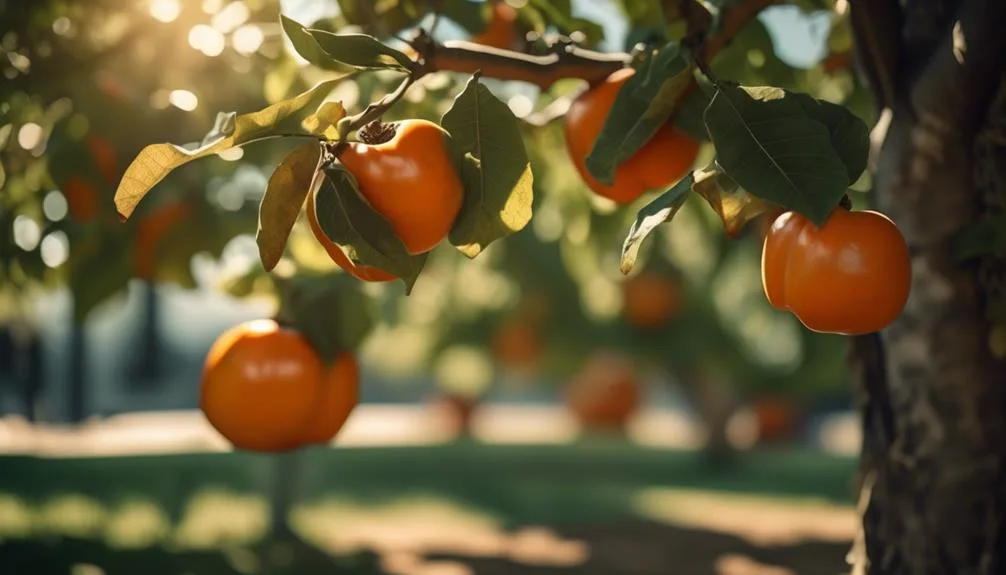When you think of trees that provide shade, oaks and willows might come to mind. But have you thought about persimmon trees?
With their beautiful leaves and tasty fruit, persimmon trees can improve your yard and offer relief from the sun. Can they really be used for shade?
Let's explore the surprising answer and discover the potential of persimmon trees for your outdoor space.
Key Takeaways
- Persimmon trees require at least 6 hours of direct sunlight per day and well-drained soil for optimal growth.
- Persimmon trees have broad and dense canopies that offer excellent shade coverage and enhance aesthetic appeal.
- Fuyu and Hachiya persimmon tree varieties are recommended for shade due to their spreading growth habit and ample shade production.
- Regular pruning, removing dead or diseased branches, thinning out crowded branches, and proper watering are essential for maintaining a healthy persimmon tree for shade production.
Suitable Conditions for Shade
In order to thrive, persimmon trees require direct sunlight for at least six hours a day, making them best suited for locations with ample sunlight and well-drained soil. When considering tree placement for shade, it's essential to select a spot that receives abundant sunlight, ensuring the persimmon tree can flourish and provide ample shade.
Sun exposure directly impacts the tree's growth and ability to produce a dense canopy, which is crucial for creating shade. Placing the tree in a sunny location also enhances the quality of the fruit it yields. Therefore, when choosing a spot for your persimmon tree, prioritize areas with maximum sun exposure.
Can Persimmon Trees Provide Shade?
Consider the potential for persimmon trees to provide ample shade in your outdoor spaces. Persimmon trees, with their broad, dense canopies, offer excellent shade coverage, making them a valuable addition to your landscaping.
The benefits of using persimmon trees for shade extend beyond just their cooling effects. Their vibrant foliage adds a pop of color to your outdoor environment, enhancing the overall aesthetic appeal of your space. Additionally, the fruit produced by persimmon trees can attract wildlife, adding another layer of interest to your landscape.
When strategically placed, persimmon trees can create shaded areas for relaxing, dining, or enjoying the view. Whether you're looking for a natural way to cool your outdoor living areas or seeking to enhance your landscape design, persimmon trees are a versatile choice for providing shade and beauty.
Best Persimmon Tree Varieties for Shade
With their broad, dense canopies and vibrant foliage, certain persimmon tree varieties are ideal for creating shaded retreats in your outdoor space.
When selecting persimmon trees for shade, consider the tree spacing and sun exposure. For a dense shade, consider planting Fuyu persimmons, which have a spreading growth habit and can be spaced 20 to 25 feet apart. Alternatively, the Hachiya persimmon, known for its large, lush leaves, can also provide ample shade and should be spaced similarly.
Both varieties thrive in full sun, making them perfect for creating cool, shaded areas in your yard.
Whether you're looking to add a peaceful spot for relaxation or a cool respite from the sun, these persimmon tree varieties are excellent choices for providing shade in your outdoor space.
Maintenance and Care for Shade
To ensure your persimmon trees continue to provide optimal shade, regular pruning and watering are essential for maintaining their health and canopy density.
When it comes to pruning techniques, it's important to start by removing dead or diseased branches to promote new growth and maintain a healthy structure. Additionally, thin out crowded branches to allow for better air circulation and sunlight penetration, which will contribute to a fuller and more effective shade canopy.
As for water requirements, persimmon trees generally thrive in well-drained soil but require regular watering, especially during dry spells, to support healthy leaf growth and shade production. Be sure to monitor the moisture levels and adjust your watering schedule accordingly.
Other Uses of Persimmon Trees
After maintaining the health and canopy density of your persimmon trees through regular pruning and watering, you can explore the various other uses of these versatile trees to maximize their benefits in your garden or landscape.
Beyond providing shade, persimmon trees offer delicious fruit that can be enjoyed fresh or used in baking, jams, and other culinary delights. The vibrant orange color of persimmon fruit adds aesthetic appeal to your garden, making it both functional and visually pleasing.
Additionally, persimmon trees are valuable for landscaping due to their ornamental value and ability to attract wildlife such as birds. Their lush foliage and attractive fruits make them an excellent choice for adding natural beauty and diversity to your outdoor space, enhancing the overall aesthetic and ecological value of your landscape.
Conclusion
In the right conditions and with proper care, persimmon trees can offer both beautiful shade and delicious fruit. Choose a suitable variety for your climate and follow proper maintenance to enjoy these benefits.
Happy planting, and may your persimmon tree bring you joy and shade for years to come!

